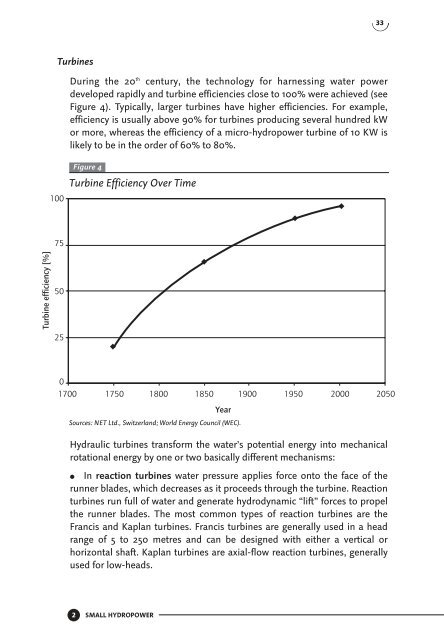Technology Status - NET Nowak Energie & Technologie AG
Technology Status - NET Nowak Energie & Technologie AG
Technology Status - NET Nowak Energie & Technologie AG
You also want an ePaper? Increase the reach of your titles
YUMPU automatically turns print PDFs into web optimized ePapers that Google loves.
Turbine efficiency [%]<br />
Turbines<br />
100<br />
75<br />
50<br />
25<br />
During the 20 th century, the technology for harnessing water power<br />
developed rapidly and turbine efficiencies close to 100% were achieved (see<br />
Figure 4). Typically, larger turbines have higher efficiencies. For example,<br />
efficiency is usually above 90% for turbines producing several hundred kW<br />
or more, whereas the efficiency of a micro-hydropower turbine of 10 KW is<br />
likely to be in the order of 60% to 80%.<br />
Figure 4<br />
Turbine Efficiency Over Time<br />
0<br />
1700 1750 1800 1850 1900 1950 2000 2050<br />
Year<br />
Sources: <strong>NET</strong> Ltd., Switzerland; World Energy Council (WEC).<br />
Hydraulic turbines transform the water’s potential energy into mechanical<br />
rotational energy by one or two basically different mechanisms:<br />
● In reaction turbines water pressure applies force onto the face of the<br />
runner blades, which decreases as it proceeds through the turbine. Reaction<br />
turbines run full of water and generate hydrodynamic “lift” forces to propel<br />
the runner blades. The most common types of reaction turbines are the<br />
Francis and Kaplan turbines. Francis turbines are generally used in a head<br />
range of 5 to 250 metres and can be designed with either a vertical or<br />
horizontal shaft. Kaplan turbines are axial-flow reaction turbines, generally<br />
used for low-heads.<br />
2<br />
SMALL HYDROPOWER<br />
33







